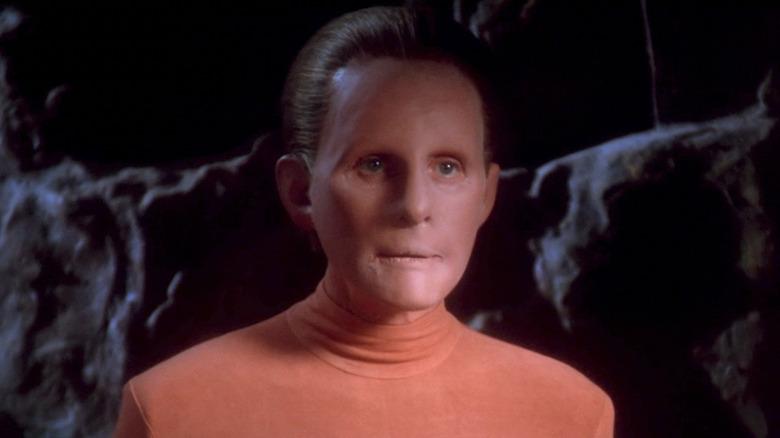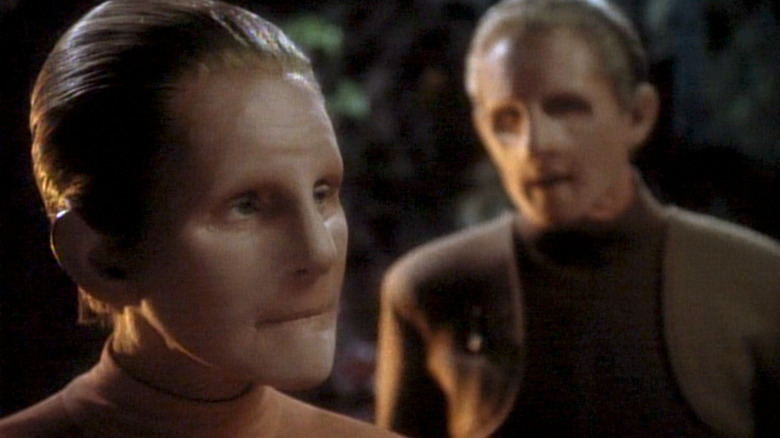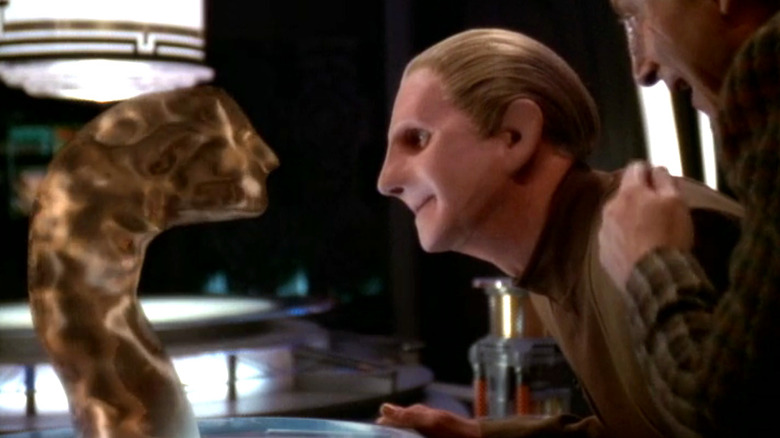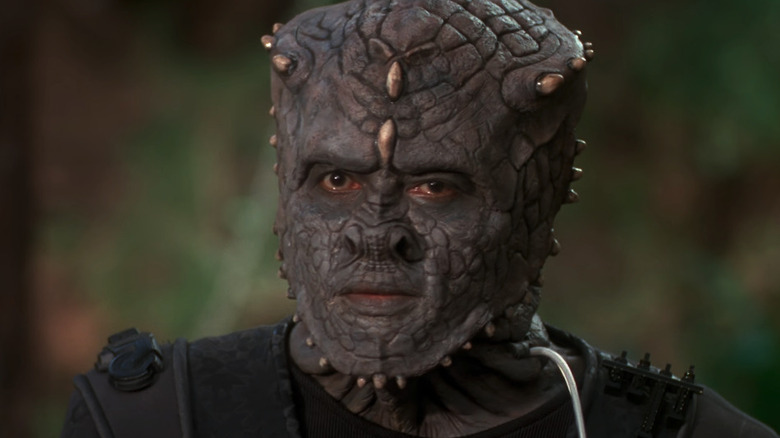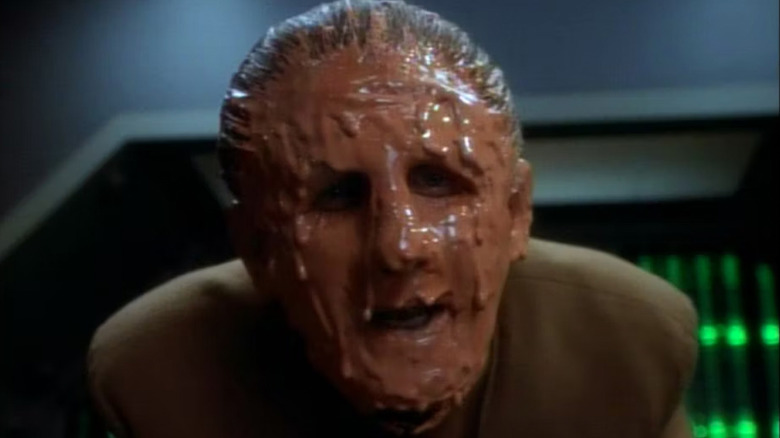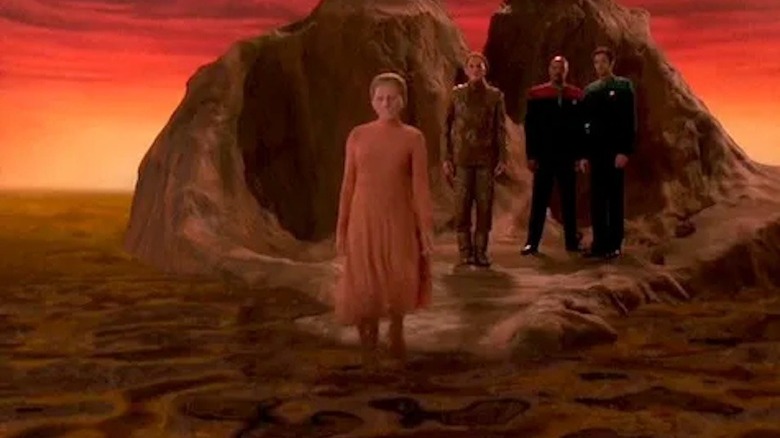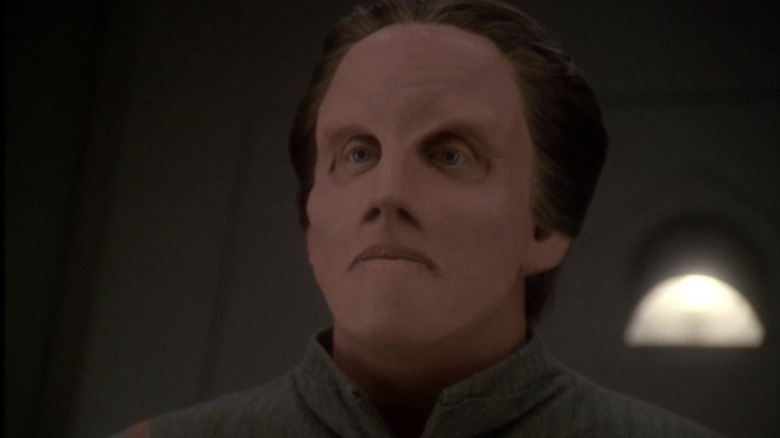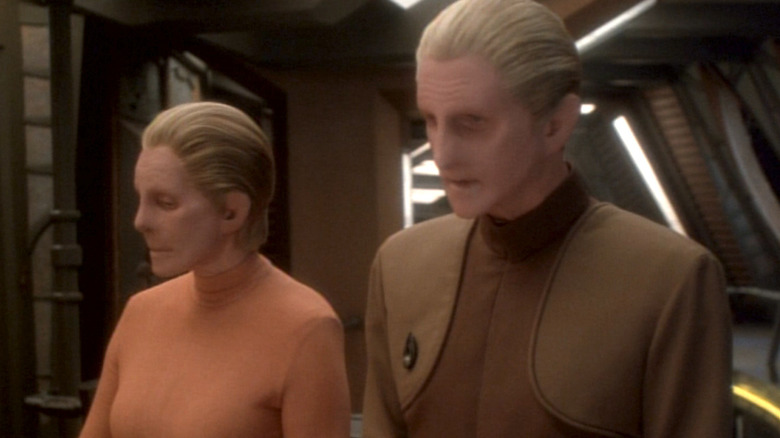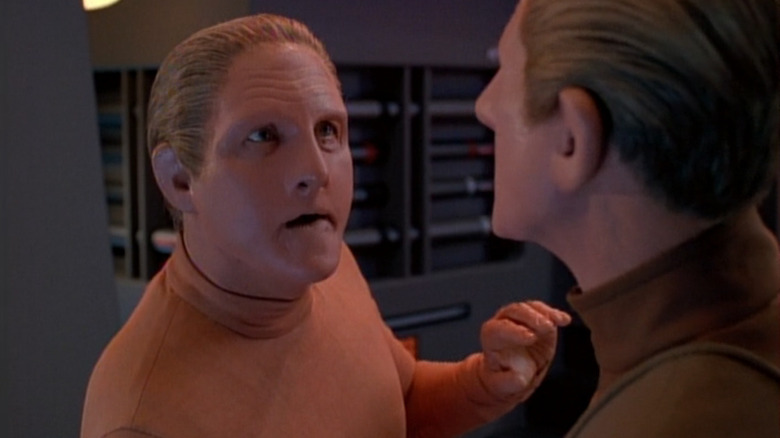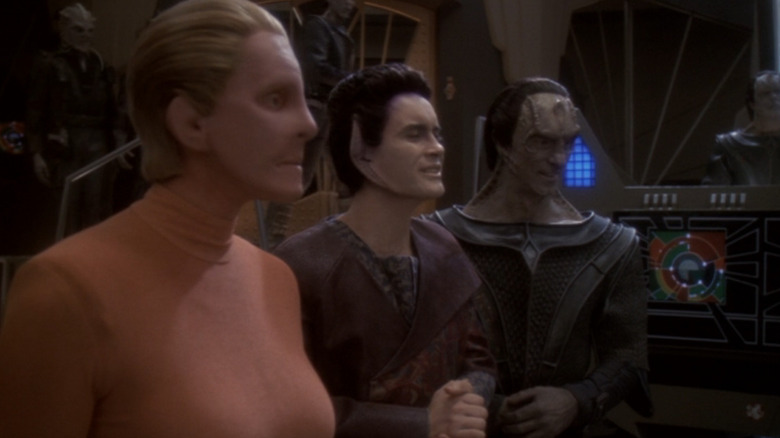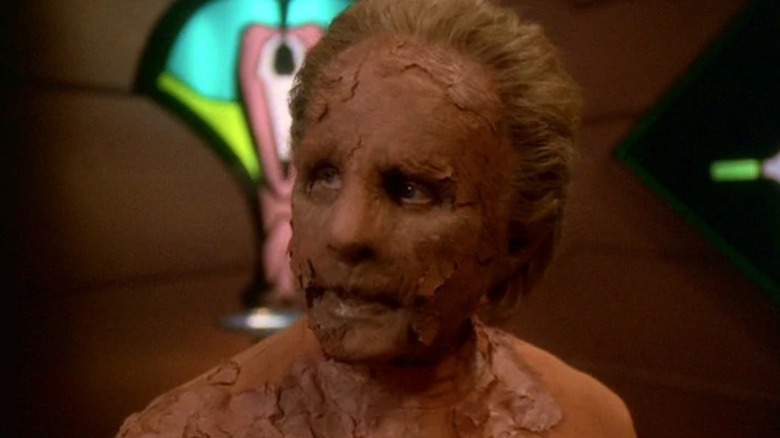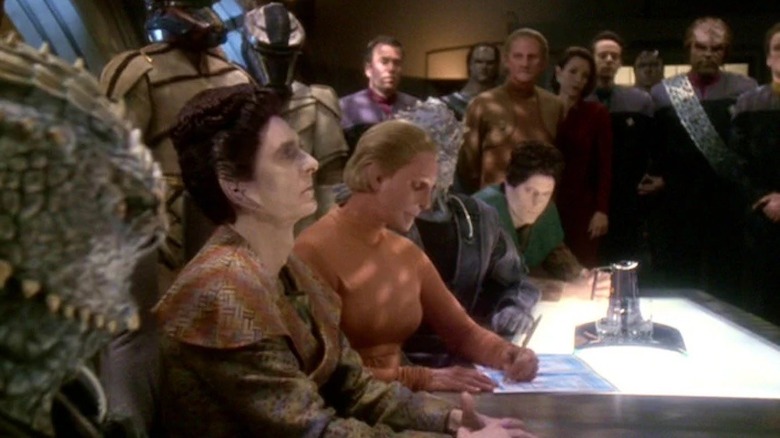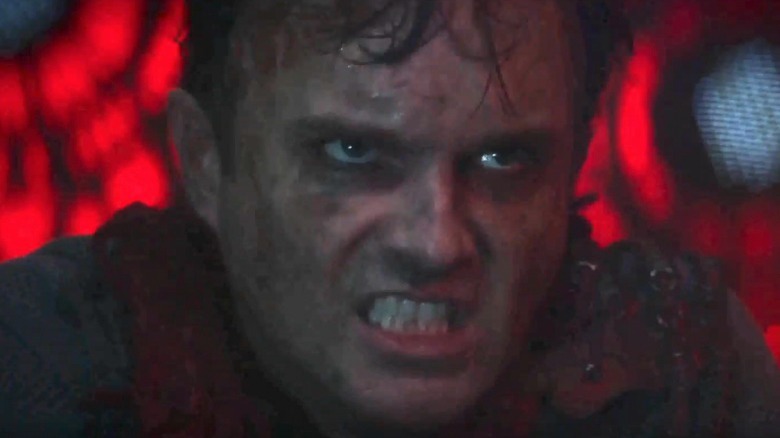Star Trek's Shapeshifting Changelings Explained
Despite not being as well known as Klingons, Romulans, or the Borg, the Changelings may be the most deadly foe the Federation and Starfleet have ever faced. Introduced in "Star Trek: Deep Space Nine," a series set on a former Cardassian space station orbiting a wormhole leading to the distant Gamma Quadrant, the Changelings would quickly form the backbone for the entire series-long story. That they were the same race as the station's enigmatic security chief Odo added another layer to the story.
Not only do the Changelings wield tremendous powers that allow them to alter their shape and form, but they are also rulers of a vast interstellar empire. With the ability to steal another person's identity and a galactic army at their disposal, they are a terrifying threat that added suspense, thrills, and chills to "Star Trek."
More recently, the Changelings have returned to the franchise after a decades-long absence, first in a brief appearance in an episode of "Star Trek: Discovery." However, Season 3 of "Star Trek: Picard" sees them return in full force to plague the Federation. If it's been a while since you've watched "Deep Space Nine" or aren't familiar with it, you may be looking for a bit of a refresher. From their long history and strange biology to their part in the dreaded Dominion, as architects of the greatest war that "Star Trek" has ever seen, here's a brief primer on the shapeshifting Changelings.
The Changeling's real life origins revealed
The Changelings didn't debut until the "Deep Space Nine" Season 3 premiere episode "The Search," but their conception goes back to an earlier directive from producers. Specifically, the showrunners wanted to create a malevolent foe from the Gamma Quadrant that would help give the series its own flavor. According to the producer Ira Steven Behr, they were nervous. "We can't risk it all on one race of villains," he said in the documentary "What We Left Behind." Instead, they set out to create three evil adversaries, hoping that one would prove popular — and they wanted to make them all terrifying.
"We're gonna make them as scary as any villains you can possibly find," Behr said in the "Deep Space Nine Companion." He told his writers to read Isaac Asimov's "Foundation" trilogy as research, and the result was the Dominion — an incredibly powerful and ancient group that ruled the Gamma Quadrant. The Jem'Hadar were their foot soldiers, the Vorta were what Behr called 'the face men,' and the Founders of the Dominion were revealed as Odo's shapeshifting people in a shocking twist.
As a result of this change, Odo, played by Rene Auberjonois, became one of the most important characters in the series thanks to his connection to the villains of the multi-season story arc that would dominate the remaining seasons.
The Changelings distant origins explained
Now that we know how the Changelings were created by writers and producers, how did they come to be in the world of "Star Trek"? If we are to believe a story told by the Vorta, their origins date back eons, and they were once solid lifeforms just like humans, Vulcans, or Klingons. Eventually, they evolved into the shapeshifters we know, and their society evolved alongside them as they set out to explore the stars and learn about the galaxy. Unfortunately, when they encountered other populated worlds, they were not greeted with open arms.
Instead, they were met with intolerance and even cruelty for no other reason than their non-solid state. As shapeshifters, they were distrusted by what they called mono-forms — ordinary beings who are confined to a single shape — who they more commonly referred to as "solids." According to the legend, the changelings were hunted by the solids and given the derogatory moniker of "changelings," which they would later co-opt in defiance of the prejudice they faced. They eventually found a haven from the solids in the Omarion Nebula, a remote region where they established a home.
Eventually, though, the Changelings realized that the only way to overcome the bigotry and intolerance of the solids was to control them. In order to conquer and enslave the rest of the galaxy, they'd first have to build an army.
They're considered gods
In the episode "Treachery, Faith and the Great River," a dying Vorta named Weyoun-6 tells Odo the story of how the Changelings founded the Dominion. According to this Weyoun, a Changeling once found itself on the run from a group of abusive solids, and a race of primitive, ape-like people helped hide the shapeshifter, saving its life. From then on, the Changeling vowed to reward the creatures who had saved it, later using their knowledge of genetics to advance their biology and create the Vorta, a highly intelligent, cunning race that would serve the Founders in all things.
Beneath the Vorta are the Jem'Hadar, a race of genetically engineered soldiers who want nothing more than to obey the Founders and are among the most efficient killers in the "Star Trek" canon. They live short lifespans but are bred quickly, aging into adulthood in a matter of days, and are kept docile thanks to an addiction to a chemical compound called Ketracel-white. But the Founders also engineered both the Vorta and the Jem'Hadar to worship them as gods, as they are, in a very real way, the masters of their creation.
Except for in the most extreme circumstances, it is nearly impossible for either race to defy the Founders. With an undying loyalty, the Vorta and the Jem'Hadar have helped assure the Changeling's supremacy and the Dominion's endless rule of the Gamma Quadrant.
Changeling biology
As shapeshifters, the Changelings have biology unlike any other race in "Star Trek." Their "morphogenic matrix" allows them to take on not just other shapes but other states of matter, too. They can hide in plain sight as a human, an Andorian, or a Tellarite, able to accurately mimic any lifeform nearly instantly. They can even replicate their voice simply by hearing it, though Constable Odo has never been able to quite master these skills.
However, their shapeshifting isn't limited to just people, as Changelings can just as easily become a tree, a rock, or even equipment with a reflective surface. We have seen Changelings become water, vapor, and even fire. Still, their biology has one serious drawback — they must regenerate in their natural, liquid state at least once every 16 hours. We've seen this weakness cause problems for Constable Odo, who must regenerate at least one hour each day by reverting to his liquid form and collecting himself in a small pail that he keeps in his quarters.
In addition, if any part of a Changeling's body is cut off, removed, or otherwise separated from them, it will revert to its liquid state almost immediately. This is how Starfleet, at first, was able to detect Changelings hiding among them by drawing a blood sample. Of course, the Changelings eventually found a way around this measure, presumably by collecting the blood of the people they were disguised as and releasing it on cue during any blood test.
The Great Link
Since they need to regenerate frequently, and due to the energy required to hold a solid form, Changelings prefer to spend the majority of their time in a liquid state. When they communicate they rarely do so verbally, as they prefer to meld together into what is referred to as "linking," which is a bit like mixing two cups of water together. When linked, Changelings cease to be individuals, merging into what is, in essence, one being. In effect, there are no true individuals among Changelings, only parts of the whole who gain brief periods of individuality when separated from the Link.
As such, the Changeling homeworld is essentially one giant ocean comprised of themselves in what is called the Great Link. During their lifespan they can become individuals to explore the galaxy and return home to the Great Link to share what they've learned. Described as "a merging of form and thought, the sharing of idea and sensation," the Great Link is a place of comfort for Changelings. However, this Great Link, covering nearly the entire surface of a planet in the Omarion Nebula, also makes a tempting target.
In the two-part "Deep Space Nine" episode, "Improbable Cause" and "The Die is Cast," the Romulan secret police known as the Tal Shiar teamed up with the Cardassian intelligence agency the Obsidian Order to destroy the Changeling homeworld. Unfortunately for the Alpha Quadrant, this all turned out to be a ruse by the Founders to eliminate both factions.
Odo and the Hundred
Though they prefer to remain in the Great Link, the Changelings still thirst for more knowledge of the galaxy. To that end, they dispatched 100 infant Changelings out amongst the stars, which they hoped would come to live among the solids and then one day return home to the Great Link to share what they had learned. When Odo met his people and discovered the Founders, he realized that he was one of these Hundred. However, now that he had spent time among the Bajorans and the Federation, he saw his people as the enemy.
While Odo refused to rejoin them, the urge to be a part of the Great Link persisted. Eventually, he'd encounter two more members of the Hundred. In the episode "The Begotten," a dying Changeling child is discovered, unable to shapeshift, and Odo takes it upon himself to become a parent to the naive, formless creature. While the Changeling eventually dies, it is absorbed into Odo and helps resolve a season-long story that had seen Constable Odo forced into a solid, humanoid shape by his people.
Later, in the episode "Chimera," Odo meets a Changeling named Laas, who has lived among another race of people for the past century. He agrees with Odo that the Founders are misguided and invites him to join his search for other lost shapeshifters to form a new, better version of the Great Link. Odo regretfully declines, feeling a duty to his friends on Deep Space Nine.
They are obsessed with order
As a result of their natural state of oneness in the Great Link, there is rarely — if ever — any disagreement or discord among their race. In fact, it's established on multiple occasions that "no Changeling has ever harmed another," a point that is thrown in Odo's face when he betrays his people and murders a Changeling saboteur in the Season 3 finale, "The Adversary." It is this act that forces the Changelings to force Odo into a solid form in the Season 4 storyline. While Odo is unlike the galaxy-conquering Changelings he comes from, he does share their innate need to bring order to chaos, which some have likened to a biological drive.
This is partly what makes Constable Odo such an efficient security officer and investigator, as his desire to bring order made him a ruthless pursuer of justice in a chaotic environment like the Cardassian space station Terek Nor, which eventually became Deep Space Nine. However, for the rest of his people, this means ruling the galaxy, as they see solids as chaotic creatures which are always fighting amongst themselves.
Ultimately, the Changelings — as Founders of the Dominion — view their conquering tactics as a means of helping those races achieve peace and order, even if they have to enslave them and break them of their desire for freedom to achieve it.
They plotted to destabilize the Alpha Quadrant
Upon discovering the wormhole, the Changelings were initially content to stay in the Gamma Quadrant. However, as the Federation and other Alpha Quadrant powers made more and more excursions into their territory, the Changelings knew that the chaos on the other side of the galaxy would soon threaten them. In their first meeting with the Federation, they ran an elaborate simulation with the crew of Deep Space Nine to see how they would react to a Dominion presence in the Alpha Quadrant, determining that they would be met with open hostility.
In response, the Changelings began staging plots to destabilize the Alpha Quadrant to make it easier to conquer. After plotting to dismantle the Cardassian and Romulan intelligence agencies, the Changelings infiltrated Starfleet in an effort to trigger a war between the Federation and the Tzenkethi in "The Adversary," revealing the extent of the Changeling threat for the first time.
The story that brought Worf to "Deep Space Nine" also sees a Changeling posing as a high-ranking Klingon official and sparking a war between the Federation and the Klingon Empire that risks decimating both sides. At the same time, Changelings begin replacing key individuals on Earth, precipitating a militaristic coup that is only thwarted by Captain Sisko. When these plots are foiled, the Federation knows that a war with the Dominion is all but inevitable.
The Dominion War explained
Following the failed attempt to force the Federation and Klingon Empire into destroying each other, the Changelings lead the Dominion deeper into direct conflict with the galactic powers of the Alpha Quadrant. They are aided by the Cardassians, who join the Dominion, fortifying their forces, and all-out war is quickly declared on the Federation and the Klingons. In what became a high point for "Deep Space Nine," the Dominion War breaks out, and what was truly groundbreaking for "Star Trek" was that victory for the Federation did not seem assured.
In fact, the Dominion succeeds in conquering Deep Space Nine in a status quo shaking story. Later, in what is generally regarded as one of the series' best episodes, "In the Pale Moonlight," Sisko takes desperate action to force the Romulans to join the Federation and Klingon alliance to tip the balance of power. The longer the war drags on, the more it seems like the Changelings would wind up taking over the Alpha Quadrant, as millions of lives were lost.
What eventually turns the tide, however, is the Cardassians themselves, who rise up to fight back against the Dominion. Led by former villain Damar, the Cardassian rebels help the alliance topple the Dominion and push them back into the Gamma Quadrant. Of course, they aren't alone, as they have a little help from Starfleet's own clandestine intelligence agency along the way.
Section 31's genocidal gambit
At the height of the Dominion War, the Changelings have driven the Federation off of Deep Space Nine. Odo stays on the station along with Major Kira, with plans of helping to sabotage the Dominion, though he often "links" with the leader of the Changelings, causing fears that he has joined their cause. What he doesn't realize is that he has inadvertently passed a deadly genetic disease to the rest of the Changelings, threatening to kill their entire species. It's later revealed that this disease is the work of Section 31, a covert Starfleet intelligence agency willing to go to extraordinary lengths to secure the safety of the Federation.
Led by Director Luther Sloan, Section 31 developed a pathogen that would infect Changelings and break down their molecular structure, making it harder for them to revert to their liquid state. Eventually, unable to assume their liquid form, they would deteriorate and die. Covertly, Section 31 infects Odo with the pathogen with hopes that he will pass it to his people — and that's exactly what happens. A last, desperate, genocidal gambit, Section 31 is willing to wipe out the entire species of Changelings to end the war.
Unfortunately, rather than convince the Changelings to surrender, it spurs them to fight to the death, promising to kill untold billions before they are exterminated.
Facing Alpha Quadrant justice
It's worth noting that the Dominion War wasn't the only ongoing story that weaved its way through seven seasons of "Deep Space Nine." The story of Captain Sisko and his connection to the Bajoran prophets is also front and center, and in the series finale, both come to a head. While Sisko battles with a demonic entity on Bajor, the greatest starship battle in "Star Trek" history takes place, with the Federation, Klingons, Romulans, and their new Cardassian allies hoping to defeat the Dominion once and for all. However, the Changelings refused to give an inch, even as their hope for victory dwindled.
It was only thanks to Odo that the Changelings finally give in. After being cured of the disease developed by Section 31 — thanks to the efforts of Dr. Bashir and Chief O'Brien in the episode "Extreme Measures." Odo links with the leader of the Changelings and heals them as well. He is also able to convince them to seek peace and avert total annihilation, but it comes at a great personal cost.
While the Changeling's leader remains in the Alpha Quadrant to face justice, Odo rejoins the Great Link in the Gamma Quadrant where he can cure his people and hopefully teach them compassion and empathy to end their destructive ways. As far as we know, Odo never returns from The Great Link.
A rogue faction resurfaces
In the "Star Trek: Picard" Season 3 episode "Seventeen Seconds" we discover in a shocking twist that the Changelings have returned to "Star Trek" after more than 20 years. What's worse, however, is that they have infiltrated Starfleet. They have an agent aboard the USS Titan, while others are involved in a plot to steal a deadly weapons from Daystrom Station.
Former Enterprise security chief Worf has been aware of this conspiracy and has been tracking down the threat. Thankfully, he is now aided by former Picard ally Raffi Musiker. Given Worf's experiences on "Deep Space Nine," he would seem to be the perfect man for the job. In fact, according to Worf, he was alerted to this rogue faction by his old friend Odo, who is still a part of the Great Link in the Gamma Quadrant.
It seems that after Dominion surrendered in the final episode of "Deep Space Nine," there was a schism within the Changelings for the first time, as a group of shapeshifters broke away and refused to accept defeat. Now it would seem that this faction is looking to reignite the war with the Federation and conquer the Alpha Quadrant once and for all.
